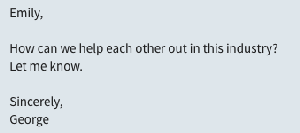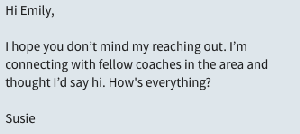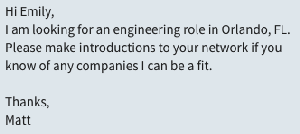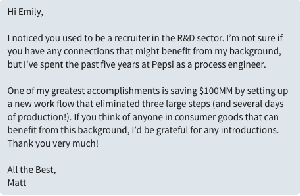The 3 Kinds of LinkedIn Messages That Are Unlikely to Get a Response
Author: Emily Liou
As a career coach, my inbox is often flooded with messages from people I’m connected with on LinkedIn who are reaching out about something or another. Now, I don’t mean to be judgmental, but I often find myself sighing with annoyance when I open them up—so much so that I was motivated to write this article.
You see, the thing is, I’m open to making new connections and willing to talk to anyone, so the fact that I often put off responding to messages means people are missing the mark. And that stinks because it takes effort to both find people to connect with in the first place and then cultivate a networking relationship from there.
I want to be excited when I read your message and I know you want that, too (or at least I hope you do!). Often times, it only takes a few tweaks to your words or tone to make that possible.
Below are messages inspired by real ones I’ve received along with my thoughts on why they’re not the best approach.
Quick note though: Unless you have LinkedIn Premium, you’ll need to connect before you send a message. But that doesn’t mean you can just send the generic invite. Instead, send a customized one with with these short templates so they’ll accept your request and you’ll be able to actually send over a note.
1. The Empty Query

Initial Reaction
It’s nice that you want to find a way to help one another out, but this message doesn’t give me anything to work with. Perhaps there’s something in my my background that led you to reach out in this manner?
Revised

Why This Is Better
Anyone can spot a generic, non-customized message from three Wi-Fi zones away, and if you care about standing out, you’ll be careful not to be labeled as generic, right? The updated version attempts to start building a rapport. By including a customized, targeted line, I can tell George has looked into my background and is excited about finding a way to potentially work together. And that makes me much more inclined to respond to this.
2. The Vague Ask

Initial Reaction
How’s everything? Hm, that’s a rather large question for someone I don’t know in real life. In fact, I’m not sure I’d even know where to begin in responding to this person.
The Revised Message

Why This Is Better
Being clear up front is just good business. It sets clear intentions and demonstrates professionalism. Many people have experienced accepting a meeting only to find it turn into a sales pitch. If you’re clear about the reason why you’re reaching out, you’re going to build a higher level of trust out the gate and find people who are attracted to your proposal. This is what building a network is all about.
3. The Forceful Demand

Initial Reaction
Hi Matt. My current profile has been updated to indicate that I’m no longer a recruiter (not to mention I definitely don’t specialize in the Florida market as I’m in Los Angeles). If you’re going to spend the time, energy, and effort in sending messages and attempting to foster relationships, it’s far more more effective if you target the correct audience.
The Revised Message

Why This Is Better
If you’re actively seeking a new position and are wanting to connect, it makes a huge difference if you can share in a couple of sentences what you’re looking for and a glimpse of what you bring to the table. Even though I’m no longer entrenched in the recruiting world, I’m still well-connected.
If Matt had demonstrated clear professionalism in a straightforward introduction, and made note of target roles he’s seeking, I’d for sure be inclined to point him to resources or ask him for his resume to pass along.
The thing to remember is that if you’re asking one of your LinkedIn contacts for something, you need to make it as easy as possible for that person to follow up.
It may be difficult to see it, but every piece of correspondence counts—from the way you first connect to how you stay connected. Don’t randomly reach out to 20 of your LI connections for the sake of hoping something falls into place in your job search. By building off of the revised templates above, you’ll be able to initiate conversations that result in meaningful networking relationships.
Photo credit: wernerimages/Getty Images.
To read the original article, click here.
4 Tips for Reaching Out to Someone You Admire on LinkedIn
Author: Lily Herman
Every LinkedIn user has had that moment: You’re scrolling through profiles and stumble upon your role model. Whether it’s someone who works for a company you love or someone who has the career of your dreams, you’re now dying to talk to him or her.
The question is, how do you reach out without it seeming weird, random, or awkward?
Well, it’s not quite as hard as you think. Here’s my advice for actually reaching out to a stranger on LinkedIn—and getting a response.
1. Figure Out if LinkedIn Is the Best Way to Reach Out
Before you click the “Message” button and declare your admiration, make sure you check that person’s profile to see if there are any specific requests about messages. For example, does he only want notes from people he already knows in person? Does she ask people with inquiries to send her an email instead of a LinkedIn message? These are things to figure out beforehand, because it could keep you from getting a response.
For example, my website, The Prospect, has a high school internship program that requires applicants to send materials to us via our company email. One day I opened up my LinkedIn profile and was surprised to find a high school student’s internship application in my inbox with no explanation of why I was receiving it on my personal profile. Not only was it random, but I could tell that the person obviously didn’t follow our application instructions. Why would I consider someone for an internship who obviously didn’t follow directions or offer any reason for doing so?
My advice? Do a little digging (er, stalking) before you send a message. For all you know, you could be shooting yourself in the foot by sending it to the wrong place.
2. Find Common Career Ground
Since LinkedIn is centered around careers, it’s important for there to be some job-related link between you and the person you admire. This could be pretty much anything, from working in the same industry to knowing a couple of the same people, but it’s important to do a little more digging—both on LinkedIn and on the web as a whole—to find that common ground. Believe me: It’s much easier to break the ice when your message is tethered to something career-related and personal than to something generic (“Hey, I see that you live in New York…”).
For example, if you saw this person speak at an event recently (as in, within the last week or so), use that as the jumping off point for a stellar opening line to your message (“I saw your speech about Y at event X and had a couple of questions for you”). If you have a mutual contact who both of you know very well, that person can also be a great tool (“Jenny Smith and I were talking the other day about awesome programmers, and she suggested I contact you”).
3. Avoid the “Can I Have a Job?” Line
This is an obvious one, yet people still do it all the time: Do not ask for a job from someone you admire but don’t know. Rarely do people hand out jobs to strangers they’ve never had any contact with before. Plus, chatting with people on LinkedIn is great for making connections with colleagues in the same field or professional circles, but it’s not meant to be the pinnacle of your professional relationship with someone—just a jumping off point. A connection on LinkedIn should lead to a working online relationship or a lunch or coffee meeting, not just more online interaction.
Some great reasons to want to contact someone on LinkedIn? If you’re looking for specific industry advice from someone in your field or wanting to meet up with someone in the future (again, be specific about why), then LinkedIn is the place to go.
And if your main reason for admiring someone is because he or she could potentially get you a job? You may want to rethink the entire reaching out process.
4. Draft Your Message
When you’re ready to reach out, write out the message you want to send before you actually send it. It’s easier said than done to say, “I’m going to tell so-and-so that I admire him!” and it’s important to think through what specifically you want out of this correspondence beforehand. Think to yourself, What would be the optimal response I’d receive from this person if everything were to go perfectly? And, How can this message open the door for said response?
Draft your message by separating out an introduction, body paragraph, and conclusion where you explain who you are, why you’re reaching out, and (briefly) what you want out of the correspondence. Again, the name of the game is brevity; your message should only be a couple of sentences tops (what person wants to read an eight-page summary on the life of someone they don’t know or don’t know well?).
I once sent a version of the following LinkedIn message to someone I briefly (literally a three-minute conversation) met at a conference two days prior:
Hi [name],
It was awesome meeting you during the lunch break at [event] this weekend and talking about our favorite college admissions websites.
I remember you were discussing how much you were hoping to re-launch your website’s social media platforms but weren’t sure where to start and wanted some outside input. If you still want some help, I’d love to be of assistance.
Let me know if this is something that interests you, and feel free to contact me at [email address]. Hope you’re having a great week!
I ended up getting a response to this message only a couple of hours later—and since then, this person I barely knew but really admired has turned into a valuable contact for me all because of a brief LinkedIn message.
Freaking out about reaching out to someone you don’t know at all? I once received this awesome message from a fellow blogger and entrepreneur I’d never met (she’s a high school student, no less):
Hi Ms. Herman,
My name is [name], and I run a student-run website called [blog name] that seeks to empower young women to follow their dreams.
I’ve been following The Prospect for quite some time now, and it’s amazing to see how much it has grown over the past several months. The Prospect really is an inspiration for my website, and I was wondering if you had any tips for growing your team while keeping the content quality up? We’re hoping to expand soon and could really use some pointers.
Thanks you so much, and congrats again for running such a great website!
Best,
[Name]
[Email address]
I loved this message because it was short, straightforward, and friendly (but not pushy). The writer asked a career-related question that wasn’t too vague (like “How do I run a website?”), and it led to me giving her my email address so we could chat (and we’re still professionally connected months later). Above all, our LinkedIn interaction led to greater connection elsewhere, which is key.
Above all, try not to overthink your message. While you should dedicate a lot of time, care, and proofreading (typos are the enemy!) to your message, at the end of the day, it should sound natural and not too stiff or overly formal. You want to come across as approachable and likeable, someone who anyone would be happy to talk to and help out.
Photo credit: the Muse.
To read the original article, click here.
How I Got 425% More Page Views on LinkedIn—and You Can, Too
Author: Aja Frost
In one week, I increased the number of people looking at my LinkedIn profile by 425%. And that’s pretty exciting—more views means more potential job opportunities, more connections, and more visibility in my industry.
Also exciting? The only thing I did differently in those seven days was start and participate in a few group discussions.
Now that I’ve discovered how beneficial it is to be an active contributor, I’m making it my goal to join group discussions at least once a week. Here’s how to do the same, so you can make your profile views soar.
1. Find the Right Group
If you’re already a member of several groups relevant to your industry, profession, or interests, great. If not, let’s fix that.
Go to the search bar at the top of the page and enter some keywords. If you’re a content strategist, try “content strategy,” “content marketing,” “creative content solutions,” and the like; if you’re into cloud computing, try “cloud computing,” “cloud storage,” “cloud services,” “cloud computing and virtualizations,” and so on. Then, in the left bar, click “Groups” to filter your results. You can also do a “blank search” (press Enter without typing anything) and let LinkedIn show you the groups it considers most relevant to you.
Groups range from the broad (like “ Content Strategy ”) to the ultra-specific (like “Women in Marketing, Chapel Hill, NC ”), and each has its merits, but don’t limit yourself to one size. If you’re just starting out, join one small group (less than 100 members), one medium group (less than 1,000 members), and one large group (anywhere from 1,000 to 100,000 members). This strategy lets you be a big fish in a small pond, a medium fish in a medium pond, and a small fish in a big pond.
One characteristic all the groups you join should share? They should all be active. If there hasn’t been any discussion in the group within the last week, pick a different one.
Sign Up Now for “How to Get a Job Using Social Media”
It’s a free class from The Muse with short, practical and—dare we say—fun lessons sent directly to you.
2. Get the Lay of the Land
Don’t do what I did, which was immediately post a discussion without looking at anything else on the group page. After getting zero responses to my question, I scrolled down to see that someone else had asked the same thing just a couple days prior.
Now, when I join a group, I’ll read through everything posted in the last week (or month, if it’s a less-active group). I note the average conversational style (casual? formal? somewhere in between?), the most successful posts (open-ended questions? discussions about industry news? requests for advice?), and the types of responses (long? short and snappy?).
This process might sound time-consuming, but it shouldn’t take more than 15 minutes, tops. Plus, not only do I generate ideas for my own posts and comments, I also learn valuable information about my field.
You don’t want to overwhelm yourself, so go to your smallest group first and spend some time getting comfortable with the vibe. As you read, jot down any thoughts you have. These will become the jumping-off points for your first posts.
3. Join a Discussion
I like to contribute to a couple of threads before I start a new one. That’s because if LinkedIn groups are like dinner parties; you don’t want to be the obnoxious guest who shows up late and then tries to dominate the conversation.
The discussion you comment on doesn’t have to be active. Say you find one from a couple weeks ago that’s come to a halt, but it’s on a topic you know stone-cold and you’d love to point out something the other members missed. Feel free to revive the discussion! However, I’d simultaneously add to an ongoing discussion to make sure you don’t end up talking to yourself.
When commenting, keep a couple things in mind:
- Statements like, “I agree with Joe,” aren’t valuable unless you expand on what Joe said, back up his point with your own experience, or in some way add new information.
- Disagreeing with people is fine, but you should remain super polite at all times. There’s nothing worse than an over-aggressive group member.
- You can promote your company, your product, or yourself, but only if it feels natural. For example, if a group member asks if anyone has read any ebooks on sales techniques, you can link to yours. If people are just talking about good techniques, don’t jump in with, “Read my ebook!”
- Relevance is key. If your comments are random, people will ignore you.
4. Start Your Own Discussion
For my first post in “LinkedIn for Journalists,” I asked the group members whether they’d invested in a personal website. This was a great post for a couple of reasons: It invited people to share their expertise, it was broad enough that anyone could contribute, whether they had a personal site or not, and there were multiple sub-topics, like whether you should pay for a site and how you can use one to promote yourself. Try to think of an open-ended question like this pertaining to your own field. (If you need inspiration, go back to the notes you took!)
You can also share articles or sites that the group would find interesting. For example, in “LinkedIn for Journalists,” I could post an article about how most people now use their phones to read the news. Using questions will increase the responses you get, so I’d add, “Has your writing changed to reflect the size of the mobile audience; and if so, how?”
Bonus: LinkedIn allows you to share your discussions on social media, so if you really want to start a healthy conversation, post the link on Twitter and Facebook.
Once you’ve commented on or started a discussion in a group, your job is technically done. Even though my website post got tons of comments, none of them were mine: I just sat back and watched the conversation unfold. However, my next goal is to take on an unofficial moderator role. I’m confident my page views will really take off!
If you try this technique, let me know on Twitter —or even find me on LinkedIn!
Photo of woman clicking mouse courtesy of Shutterstock .
To read the original article, click here.




